[Updated August 6, 2023]
Fall in North Carolina is particularly special because the autumn leaves are around for an extended amount of time.
The vibrant fall colors almost seem to develop in shifts, gradually working their way down the sides of the Blue Ridge Mountains as seasonal temperatures begin to drop.
Leaves changing in North Carolina usually start in mid- to late-September at higher altitudes (see: Mount Mitchell, Clingmans Dome, Richland Balsam).
In the areas around Asheville, Cherokee, and Waynesville, the peak leaf-peeping season occasionally pushes into early November.
In North Carolina, fall is a true season, sprawling over 3 months. The North Carolina mountains arguably offer some of the very best places to see fall colors in the United States.
Whether it’s hiking in Pisgah National Forest, driving the Blue Ridge Parkway, or simply enjoying dinner/drinks with a stunning view, there are a bounty of options for enjoying fall foliage in North Carolina.
Read on for our picks for the 25 best places to see fall in the Blue Ridge Mountains of North Carolina, including many breathtaking photos taken on a Blue Ridge Parkway road trip!
READ MORE: The 15 Best Blue Ridge Parkway Hotels & Cabin Rentals in NC & VA
Fall Colors in NC Guide
- Graveyard Fields
- Grandfather Mountain State Park
- Beech Mountain
- Craggy Gardens
- Clingman’s Dome
- Pisgah Inn
- Black Balsam Knob
- Devil’s Courthouse
- The Blowing Rock
- Banner Elk
- Looking Glass Rock
- Cowee Mountain Overlook
- Julian Price Memorial Park
- Linville Falls & Linville Gorge Wilderness
- Chimney Rock State Park
- Mount Mitchell
- Rough Ridge/Linn Cove Viaduct
-
Thunderstruck Ridge
-
Waterrock Knob/View Yellow Face
-
Chestnut Cove Overlook
- Great Smoky Mountains Railroad
- DuPont State Forest
- Brevard Waterfalls
- Little Switzerland
- Beacon Heights Overlook
READ MORE: The 15 Best Fall Fairs in North Carolina to Visit
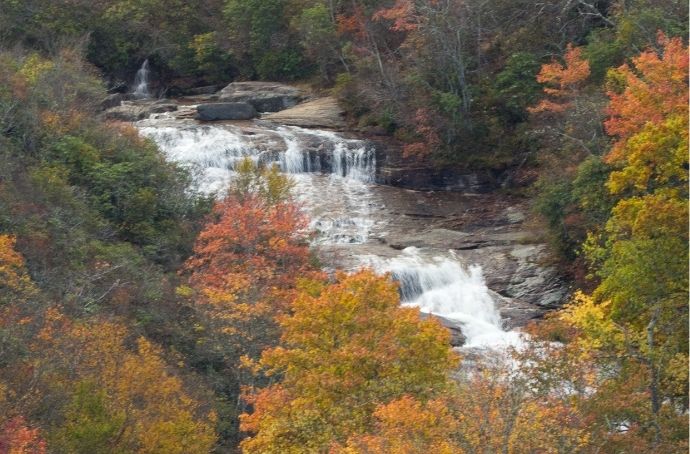
1. Graveyard Fields
The Blue Ridge Parkway fall colors have already got a fantastic reputation, so it’s just a matter of finding the best spots along the world-renowned route to stop and take them.
Graveyard Fields, which was named for tree stumps left behind after a storm several hundred years ago because they looked like gravestones, is most definitely in the running.
Located just 30 miles southwest of Asheville along the BRP, Graveyard Fields is one of the most popular (read: often crowded) of the famous roadway’s sites.
It has an amazing hiking trail that leads trekkers to two wondrous waterfalls, past open blueberry patches, and through a picturesque high mountain valley.
This spot is also highly regarded for its vivid NC fall foliage, which frames many of the stunning waterfall views.
READ MORE: The 35 Best Things to Do in Asheville NC
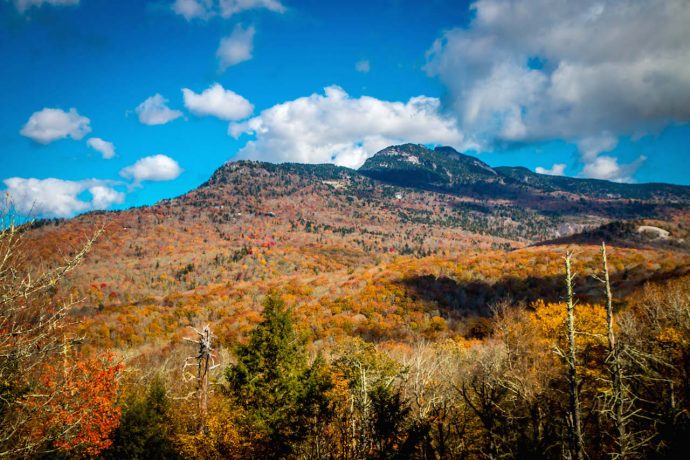
2. Grandfather Mountain State Park
Looming large at 5,946 feet, Grandfather Mountain is an iconic landmark in Banner Elk NC. It’s also the centerpiece of one of the most wonderful state parks in North Carolina.
Boasting nearly 2,500 acres of rugged backcountry wilderness, the park has a lot of space to explore within it.
But the vast panoramas viewed from the rocky outcrops along its 12 miles of hiking trails are what Grandfather Mountain State Park is most known for.
The photo above should help you imagine their glorious splendor when draped in North Carolina‘s fall colors.
In addition to the marvelous hiking trails, the nearby Grandfather Mountain Stewardship Foundation offers a mile-high swinging bridge that can be accessed for a small fee (which goes towards the park’s conservation efforts).
READ MORE: The 15 Best Things to Do in Banner Elk NC
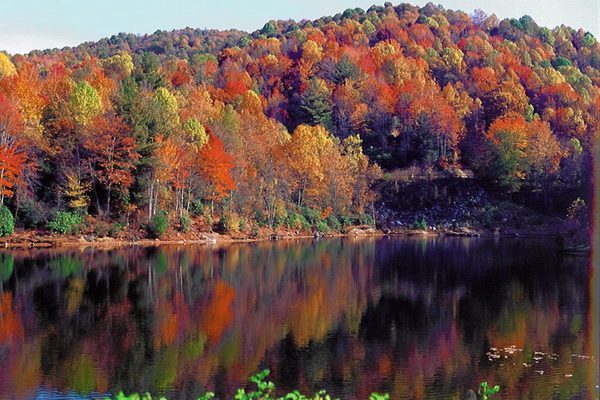
3. Beech Mountain
The highest town east of the Mississippi, Beech Mountain is widely considered one of the best places for snow skiing in North Carolina.
The peak’s lofty perch also makes Beech Mountain a picturesque spot for seeing the fall colors in North Carolina.
Riddled with outdoor recreation opportunities, from tennis to trout fishing, Beech Mountain is a resort town with all the amenities.
You’ll find scenic chair lifts, family-friendly activities, hiking trails, scenic dining spots, and lodging options for groups of all sizes from condos and chalets to private homes.
The Blue Ridge mountain town’s elevation– 5506 feet above sea level– supplies expansive views of the peaks and valleys below it.
In short, this is a prime spot for seeing North Carolina leaf-change in luxury!
READ MORE: The 20 Best Western NC Small Towns To Visit (and Live In!)

4. Craggy Gardens
Located just 19 miles northeast of Asheville, Craggy Gardens is another of the most treasured stops along the BRP.
It’s truly an ideal place for see Asheville in the fall, not to mention a stunning option for seeing wildflowers in late spring and summer.
Located at Milepost 364 (and several other nearby stops), Craggy Gardens is full of rocky terrain, with twisted tree trunks and low-slung hardwood canopies.
The mountain is pushing 6,000 feet in elevation, so the jaw-dropping landscape expands out for miles in every direction.
The prize-winning roost from which to enjoy the best fall colors of the Blue Ridge Parkway is the summit of Craggy Pinnacle, with its staggering 360º views.
READ MORE: The 10 Best Things to Do in Winston Salem NC
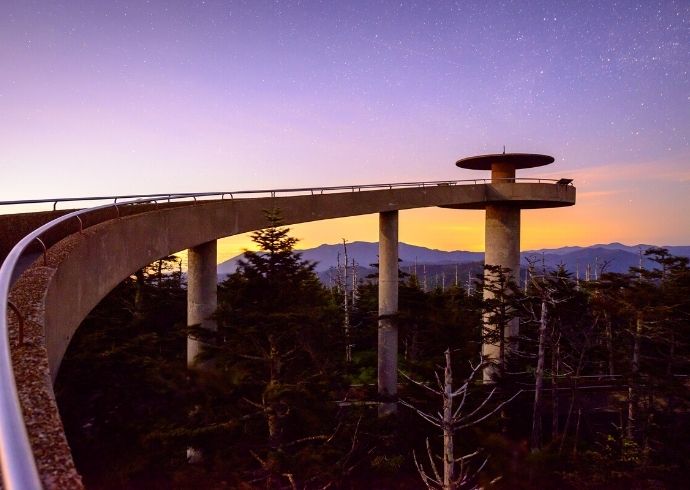
5. Clingman’s Dome
North Carolina’s Mount Mitchell is the highest point east of the Rockies, and Clingman’s Dome along the TN border is the second highest.
Technically speaking, its highest point is in Tennessee, but of course views aren’t technical!
Located at 6,643 feet above sea level, Clingman’s Dome is arguably the ultimate highlight of a visit to Great Smoky Mountains National Park.
There’s an amazing scenic drive up to approximately 300 feet below the summit. Then, at the very top, there’s a 45-foot tower from which to view all the awesomeness below.
A destination on both the Appalachian Trail in North Carolina and the Mountains-to-Sea Trail, Clingman’s Dome is a literally the high-point of many hikers’ and leaf-peepers’ journey.
READ MORE: The 15 Best Things to Do in Cherokee NC & the Qualla Boundary
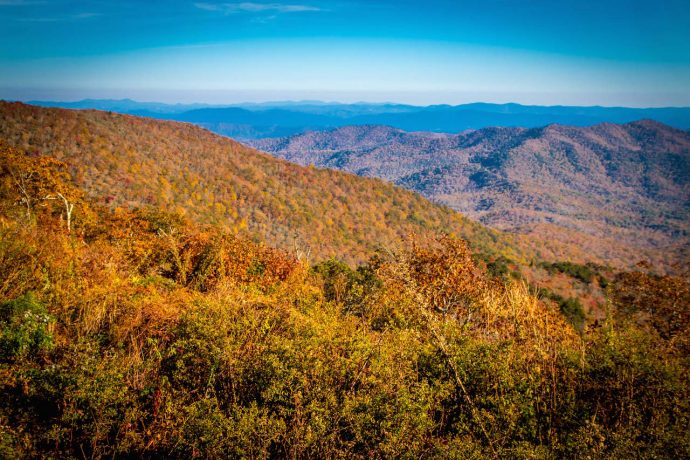
6. Mt. Pisgah/Pisgah Inn
Located between Brevard and Asheville on the Blue Ridge Parkway, the Pisgah Inn was established in 1919 (nearly 20 years before Parkway construction began) and rebuilt in the 1960s.
Located way up high atop Mt. Pisgah, the inn is home to some of the BRP’s most iconic views.
This is a great option for those who are unable (or simply unwilling) to tackle big Blue Ridge Parkway hiking trails, but still want to check out the fall colors in NC.
Though numerous trails are available nearby, the Pisgah Inn is a fantastic place to just sit back in a deck chair and soak it all in, with no sweat required.
There’s also outdoor seating at the hotel’s restaurant, as well as an observation deck and picnic areas.
READ MORE: The 25 Best Blue Ridge Parkway Waterfalls in North Carolina
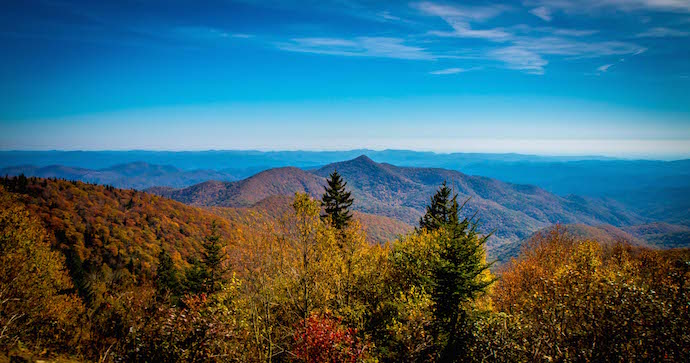
7. Black Balsam Knob
The 28.5-mile Art Loeb Trail is widely considered one of the best Pisgah National Forest hiking trails.
Black Balsam Knob is its loftiest point and offers the best views of North Carolina’s fall foliage along the trail (and arguably in all of Pisgah Forest).
Fortunately, visitors don’t have to hike the entire Art Loeb Trail in order to appreciate the scenery from Black Balsam Knob. Simply turn off of the Blue Ridge Parkway onto Black Balsam Road (FS 816).
This is a very popular spot, so it’s best to arrive early or be prepared for crowds vying to get the same scenic vistas.
Also, thunderstorms here are notorious for making a quick impression!
READ MORE: The 20 Best Places to See Fall Foliage in the Smoky Mountains
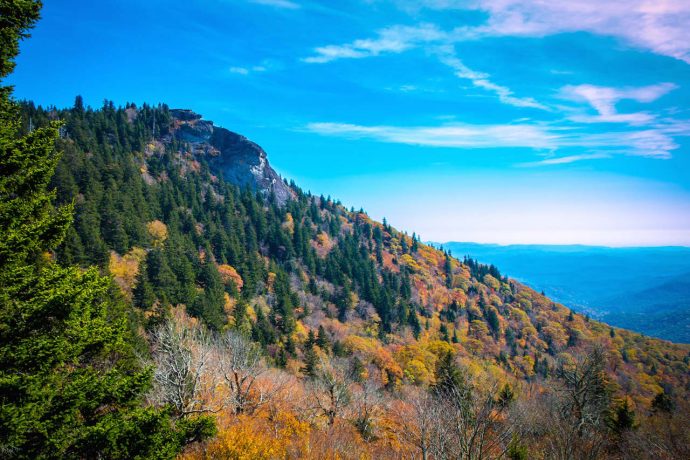
8. Devil’s Courthouse
Located relatively close to Graveyard Fields and Black Balsam Knob, the Devil’s Courthouse is another one of the more iconic natural attractions near Asheville.
At Milepost 422.4 on the Blue Ridge Parkway, Devil’s Courthouse is a location filled with Appalachian folklore, as well as a fantastic lookout for NC fall foliage.
There is a half-mile hike up to a rocky viewing platform that boosts observations of four different states: North Carolina, western South Carolina, eastern Tennessee, and North Georgia.
It’s a lofty location so nice, even Peregrine Falcons have chosen to nest there!
READ MORE: The 20 Best Overlooks on the Blue Ridge Parkway in Fall
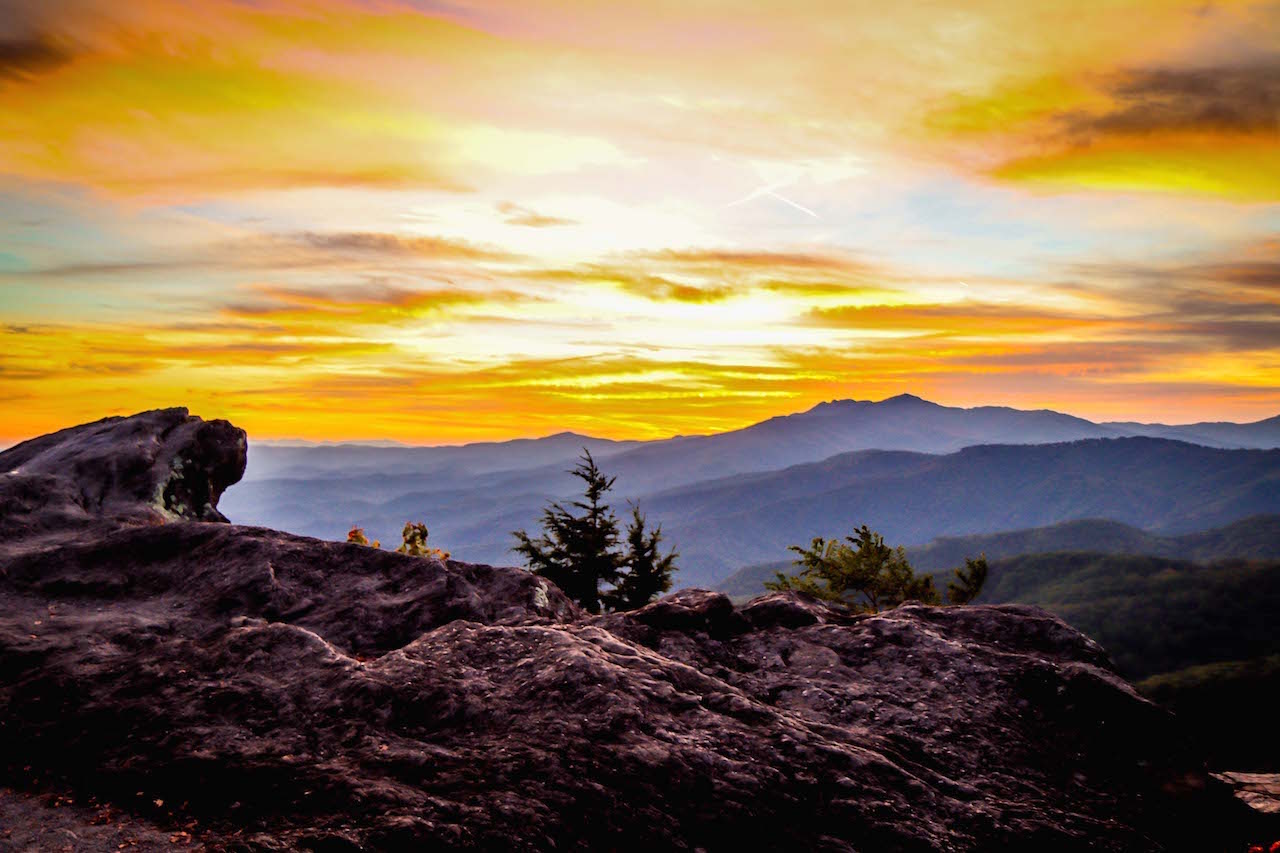
9. The Blowing Rock
“The Blowing Rock,” which is dramatically poised above the Blue Ridge mountain town that bears its name, is one of the oldest and most revered tourist attractions in North Carolina.
It’s located at 4,000 feet above sea level, overhanging the Johns River Gorge 3,000 feet below.
So the Blowing Rock yields jaw-dropping views of Mount Mitchell, Grandfather Mountain, Table Rock, and Hawksbill Mountain (not to mention all of the fall colors in between).
Unlike most of the state parks and national parks along the BRP, taking in views from “The Blowing Rock” costs a nominal fee.
But the town of Blowing Rock is free to visit, and there are lots of attractions in and around it.
READ MORE: The 20 Best Things to Do in Blowing Rock NC

10. Banner Elk NC
Banner Elk is one of the many great small North Carolina mountain towns in the High Country. It’s also one of the best destinations to visit if you want to see fall colors in NC.
The leaf color around Banner Elk (3,700 feet) typically peaks in the latter half of October, and there are many close options for viewing them.
You can paddle canoes and kayaks on local lakes, climb high at Emerald Outback, visit the Land of Oz (a Wizard of Oz theme park), or simply stroll along the beautiful Banner Elk Greenway.
Located between Beech Mountain and the Linville Gorge Wilderness, Banner Elk also makes for a convenient home base for seeing Fall colors on the Blue Ridge Parkway from late September into mid-November.
READ MORE: The 10 Best Things to Do in Banner Elk NC
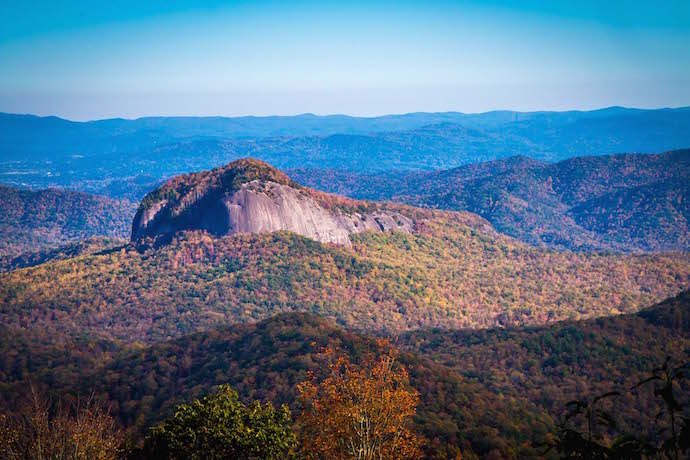
11. Looking Glass Rock
An ancient pluton formed by hardened magma underneath the earth’s surface, Looking Glass Rock gets its name from the rock face’s glossy reflection after a rain.
However, it is also possible to hike 2.7 miles to the top of Looking Glass Rock for a phenomenal view of the forest (Pisgah National Forest, to be specific) from which it ascends.
The Looking Glass Rock Trailhead is located near Brevard NC. It can be accessed from US-276, which is the main thoroughfare through the southern section of Pisgah Forest.
It’s also worth stopping by for a glimpse of Looking Glass Falls, which is one of the most accessible roadside waterfalls of note in the forest.
READ MORE: The Ultimate Pisgah National Forest Camping Guide
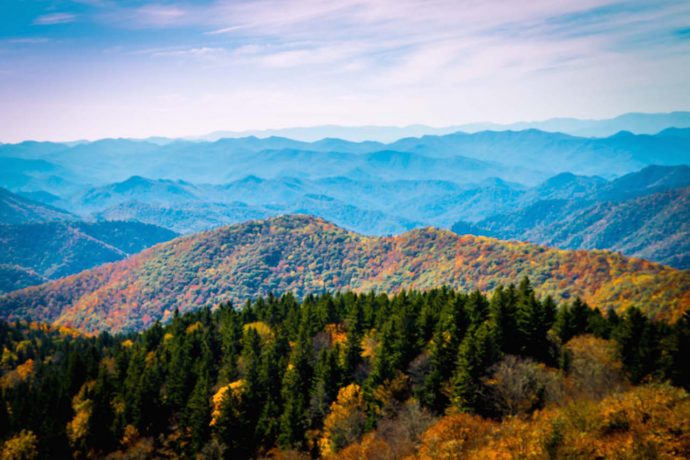
12. Cowee Mountain Overlook
Widely considered amongst the best Blue Ridge Parkway overlooks, the Cowee Mountain Overlook offers up many layers of mountain ridges in its wide, deep panorama.
Located at BRP milepost 430.7, this amazing overlook is southwest of Asheville and sits at over 5,900 feet in elevation.
Facing westward into the southern Appalachian Mountains, the Cowee Mountain Overlook is well-regarded as a great place for getting photos of sunsets.
So visitors should expect plenty of tripods and onlookers trying to get the perfect shot. Hey, it didn’t make this list for nothing!
READ MORE: The 15 Best Things to Do in Waynesville NC & Haywood County
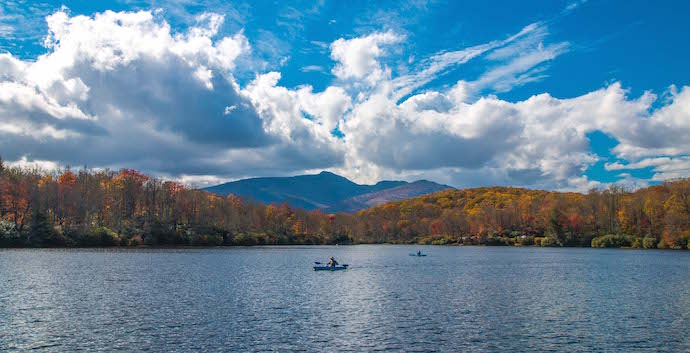
13. Julian Price Memorial Park
If you love water as much as we do, Julian Price Memorial Park offers a campground, magnificent mountain lake and numerous streams lined with colorful hardwood trees.
The backdrop of majestic mountain peaks towering over them makes for some seriously stunning photos!
Located at Milepost 297, the memorial park is part of the larger Blue Ridge Parkway system, and has a very easy 3-mile trail that loops around the lake.
This place is incredibly special to locals and travelers alike for its immediate proximity to the beauty and grandeur of the Blue Ridge Parkway in Fall.
The equally gorgeous Moses H Cone Memorial Park is also nearby, and well worth a visit.
READ MORE: The 10 Best Lakes in the North Carolina Mountains to Visit
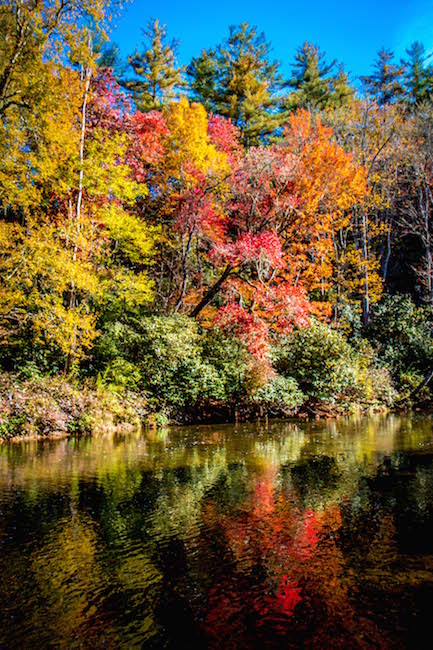
14. Linville Falls & Linville Gorge Wilderness
Linville Falls is one of the most celebrated waterfalls along the Blue Ridge Parkway. And Linville Gorge is so spectacular, it is often referred to as “the Grand Canyon of the East.”
The hiking trails that lead to Linville Falls have several spurs for getting different perspectives of the multi-leveled waterfall, which breaks out of the forest and plunges some 90 feet down.
Managed by Pisgah National Forest, the Linville Gorge Wilderness Area is a unique and rugged landscape within the forest. There are nearly 40 miles of trails upon which to explore it.
The Linville Falls Visitor Center is located at Milepost 316.4 on the Blue Ridge Parkway, and has a quaint little trail that runs behind it.
READ MORE: The 20 Best North Carolina Music Festivals in 2022

15. Chimney Rock State Park
Pushing the limits of what we can call Western NC, Chimney Rock State Park is in the North Carolina Piedmont region.
Nevertheless, we’re still talking about a place less than 30 miles from Downtown Asheville.
Chimney Rock State Park has one of NC’s most iconic rock formations– the spire for which the park is named.
For a fee, visitors can climb to the top of Chimney Rock to look down on Lake Lure (the filming site for Dirty Dancing’s lake scenes) and Hickory Nut Gorge.
Aside from the spire itself, Chimney Rock State Park boats over 5,700 acres of wilderness, including the beautiful Rocky Broad River and Hickory Nut Falls.
Chimney Rock Village is a proper little mountain town with tattoo shops, greasy spoons, and an eminently walkable Main Street. In other words, this one is a great place for families!
READ MORE: Apple Picking in North Carolina: The 10 Best NC Apple Orchards to Visit
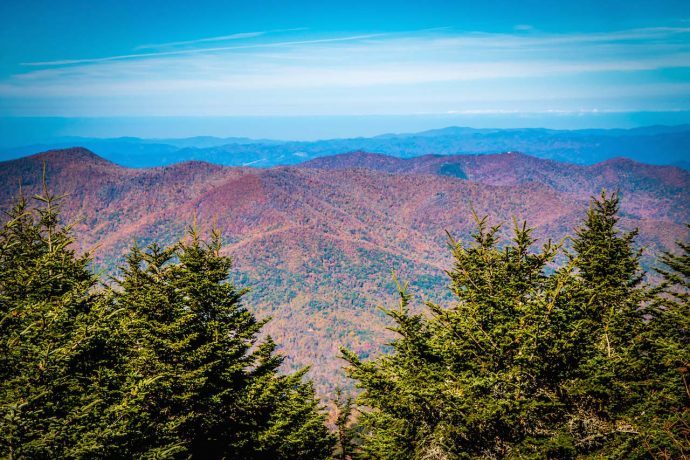
16. Mount Mitchell
Located near the town of Burnsville at BRP Milepost 355, Mount Mitchell State Park is named for the tallest mountain this side of the Mississippi River (6,684 feet).
Mount Mitchell is a popular tourist attraction all year round, offering seven hiking trails and about 15 miles worth of pathways to enjoy.
There’s also a concession stand, souvenir shop, and restaurant open during peak summer.
But it is particularly picturesque when the autumn leaves begin to turn at the upper elevations, which can be seen from the fairly short, accessible trail to the lookout at the summit.
There are also exceptional views of the lower elevations from the picnic area near the summit parking lot, which includes two picnic shelters with fireplaces, 40 tables, stone grills, and fresh drinking water.
READ MORE: The 15 Best Things to Do in Burnsville NC
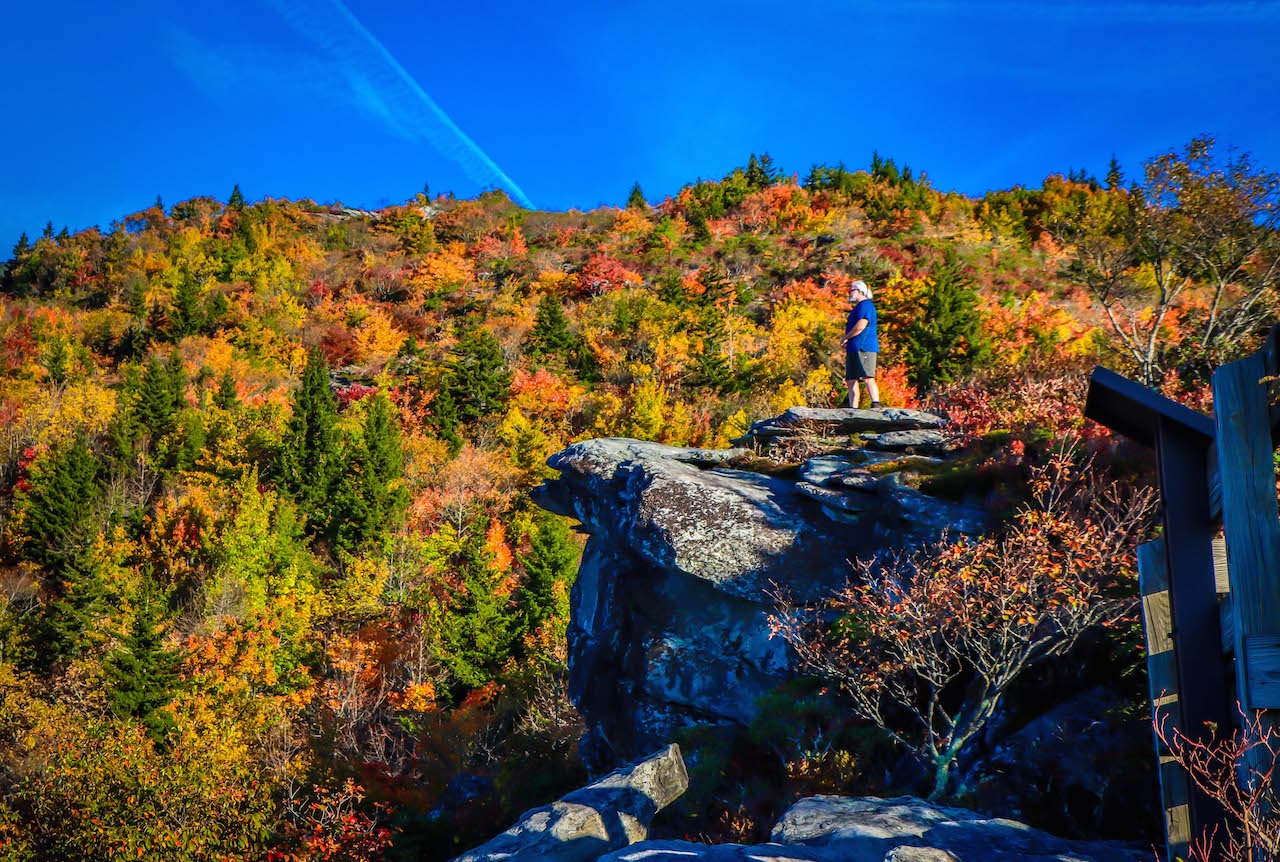
17. Rough Ridge/Linn Cove Viaduct
One of the more difficult scenic viewpoints on this list to reach, the hike to Rough Ridge begins at the parking lot, which is located at BRP Milepost 302.8.
From there you’ll hike approximate 1/3-mile uphill, gaining 480 feet of elevation along the way, to a boardwalk atop the mountain that’s designed with the Leave No Trace principles in mind.
Hiking another 1/2-mile (with large boulders along the way perfect for taking breaks) will take you to the 4,773-foot Rough Ridge summit, with its breathtaking views of autumn on Grandfather Mountain, the Linn Cove Viaduct, and the North Carolina Piedmont.
For those who are unwilling (or unable) to make the short, steep climb, the scenery from the Linn Cove Viaduct below is equally gorgeous.
READ MORE: The 20 Best Pumpkin Patches in the NC Mountains
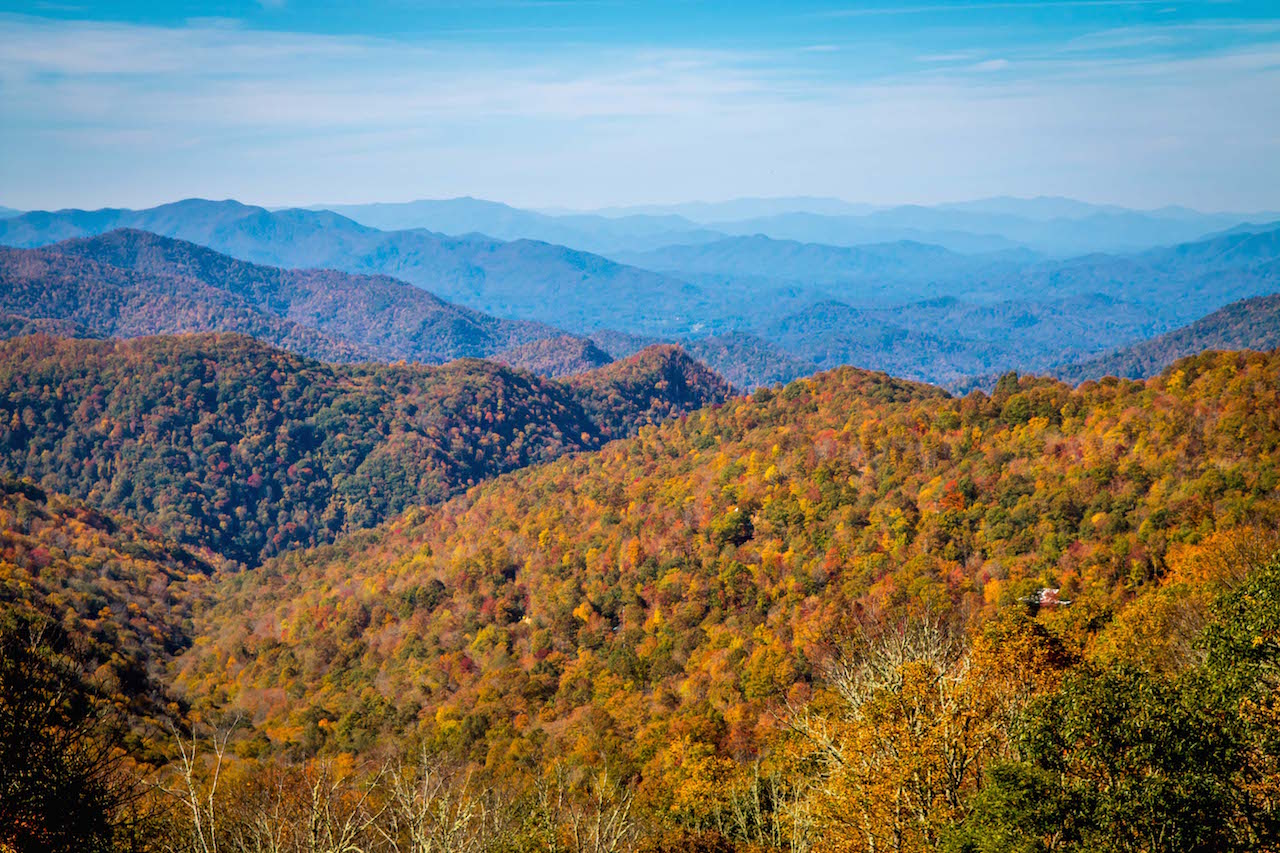
18. Thunderstruck Ridge
Located near Maggie Valley at BRP Milepost 454.4, the Thunderstruck Ridge Overlook offers exceptional vistas of the mountains and valleys below.
But what really makes this overlook stand out is the varying elevations of the mountains behind the ridge, which seem to stretch endlessly into the horizon.
Want crazy reds, oranges, and yellows? Check! Want an array of dynamic peaks? Check!
Want that trademark misty haze that gives the Blue Ridge Mountains their name? You got it!
READ MORE: The 10 Best North Carolina Haunted Houses to Visit

19. Waterrock Knob/View Yellow Face
Located in Sylva NC at BRP Milepost 451, the Waterrock Knob Visitors Center is the highest on the Blue Ridge Parkway, with an elevation of 5,820 feet.
This is a very popular overlook, and with good reason: In addition to a Ranger Station where you can get advice on local hiking trails, there’s a nearly 360º view of the surrounding mountains from the parking lot.
We got some great photos of the Parkway from there. But overall, I preferred the scenery at the View Yellow Face Overlook just down the road (Milepost 450.2).
To understand why, just check out the photo above.
Each of the ridges in foreground shows the NC fall colors in varying degrees of intensity, with the crest of the Blue Ridge range stretching out in the background.
READ MORE: The 10 Most Haunted Places in North Carolina

20. Chestnut Cove Overlook
Located almost halfway between Asheville and Hendersonville at Milepost 398.3, Chestnut Cove is one of the more underrated Blue Ridge Parkway overlooks.
But, as you can see in the photo above, it’s a gorgeous spot when the fall leaves in North Carolina are illuminated with morning light.
This was one of our first stops as we made our way north from the Historic Engadine Inn to the Linville area.
The morning fog hovering at low elevations made the dramatic ridge look a bit like a sleeping dragon or crocodile.
And with the lower elevation trees directly in the foreground, the contrast with the vivid mountains made it clear just how dynamic the colors of fall in North Carolina truly are.
READ MORE: The 15 Best Things to Do in Hendersonville NC

21. Great Smoky Mountains Railroad
In addition to being one of our favorite Christmas Towns in North Carolina, Bryson City is also a fantastic area for North Carolina leaf-peeping.
From the Tuckaseegee River and Fontana Lake to the Deep Creek Trail waterfalls and the Nantahala National Forest, the town ranks high among the best places to see fall colors in NC.
Riding the Smoky Mountains Railroad is a wonderful way to immerse yourself in the beauty of the season.
It takes you through the Nantahala National Forest, along the shores of Fontana Lake, and right next to the Nantahala River (one of our favorite places in North Carolina for white water rafting).
For 2022 the GSMR is launching new Fall Sunset Train Tours from Bryson City towards Dillsboro. These special leaf-peeping trips will be offered on Saturdays and Sundays, from October 15 to 30.
READ MORE: The 15 Best Things to Do in Bryson City NC & Swain County
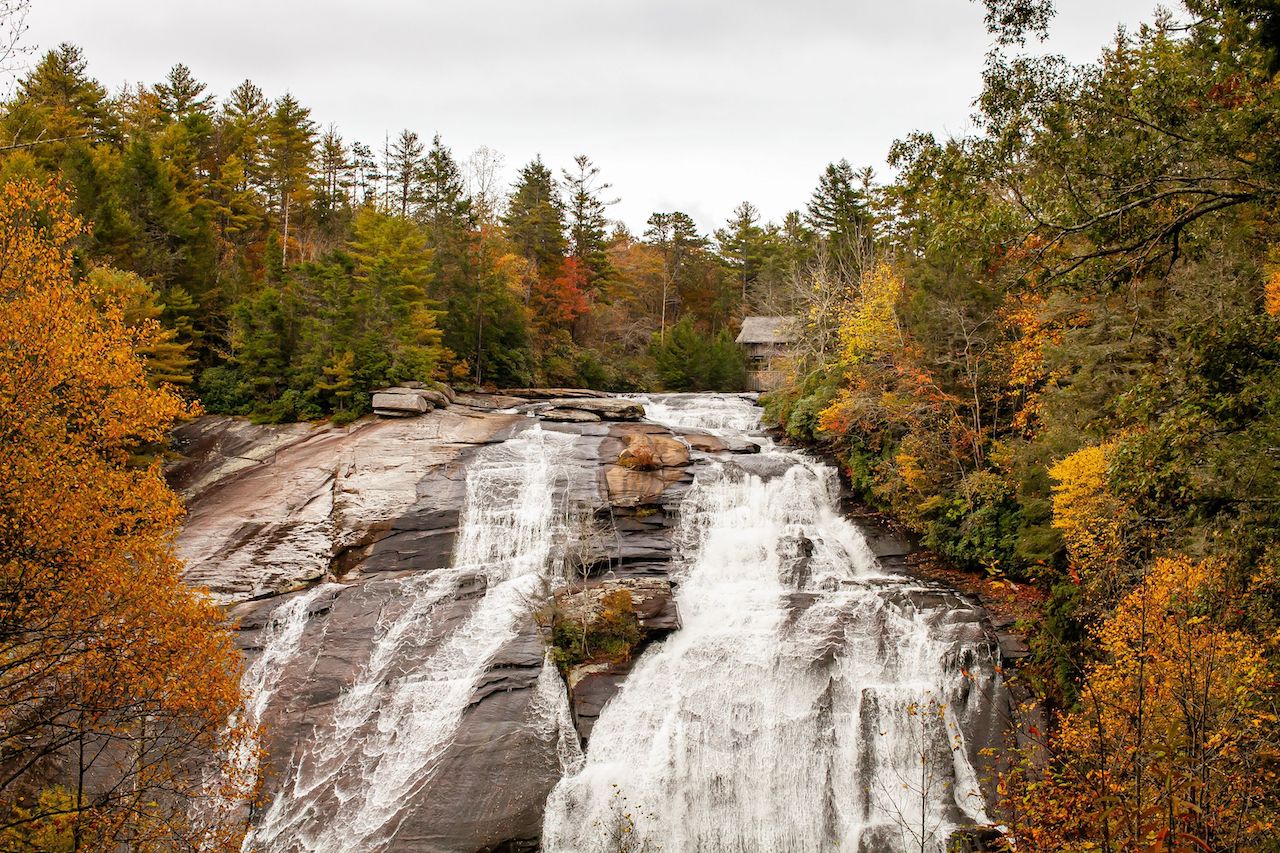
22. DuPont State Forest
The 12,000+ acre DuPont State Recreational Forest (a.k.a. DuPont State Forest) is one of the best places in North Carolina to visit at any time of year.
Located 12 miles eastern of Brevard NC in Transylvania County, the pristine park is home to some of the most beautiful North Carolina waterfalls we’ve visited, including Bridal Veil Falls, High Falls, Hooker Falls, and Triple Falls.
The lush forest also offers more than 80 miles of multi-use trails (for hiking, mountain biking, and horseback riding), several lakes (for swimming, kayaking, and fishing), and a great collection of picnic shelters.
But as lovely as it is in spring and summer, the forest reaches an otherworldly level of beauty in autumn, when its hardwoods glow in the sunlight with gem-like leaves of green, crimson, and gold.
READ MORE: The Best Things to Do in DuPont State Forest, NC
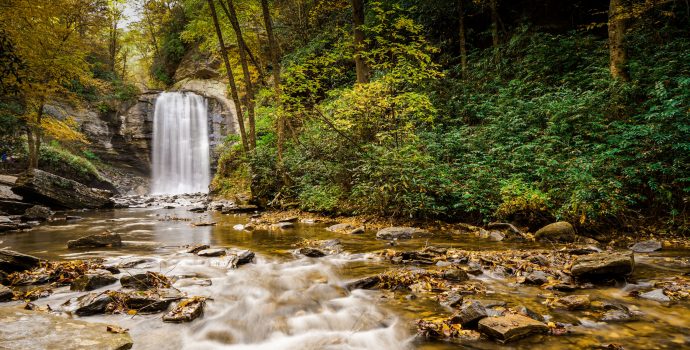
23. Brevard Waterfalls
Widely known as the “Land of Waterfalls,” Brevard and Transylvania County are home to more than 250 beautiful Western North Carolina waterfalls.
With glistening water tumbling over rock faces into tranquil pools, surrounded by wildflowers such as evergreen Rhododendrons, these waterfalls are aesthetically appealing all year round.
But they’re especially picturesque in autumn, when they’re framed by brilliant hues of yellow, orange, and red.
There are an endless array of hiking trails to waterfalls to choose from, but popular options include French Broad Falls, Looking Glass Falls, Moore Cove Falls, and the many waterfalls in DuPont Forest.
READ MORE: The Top 15 Waterfalls Near Brevard NC (Transylvania County)
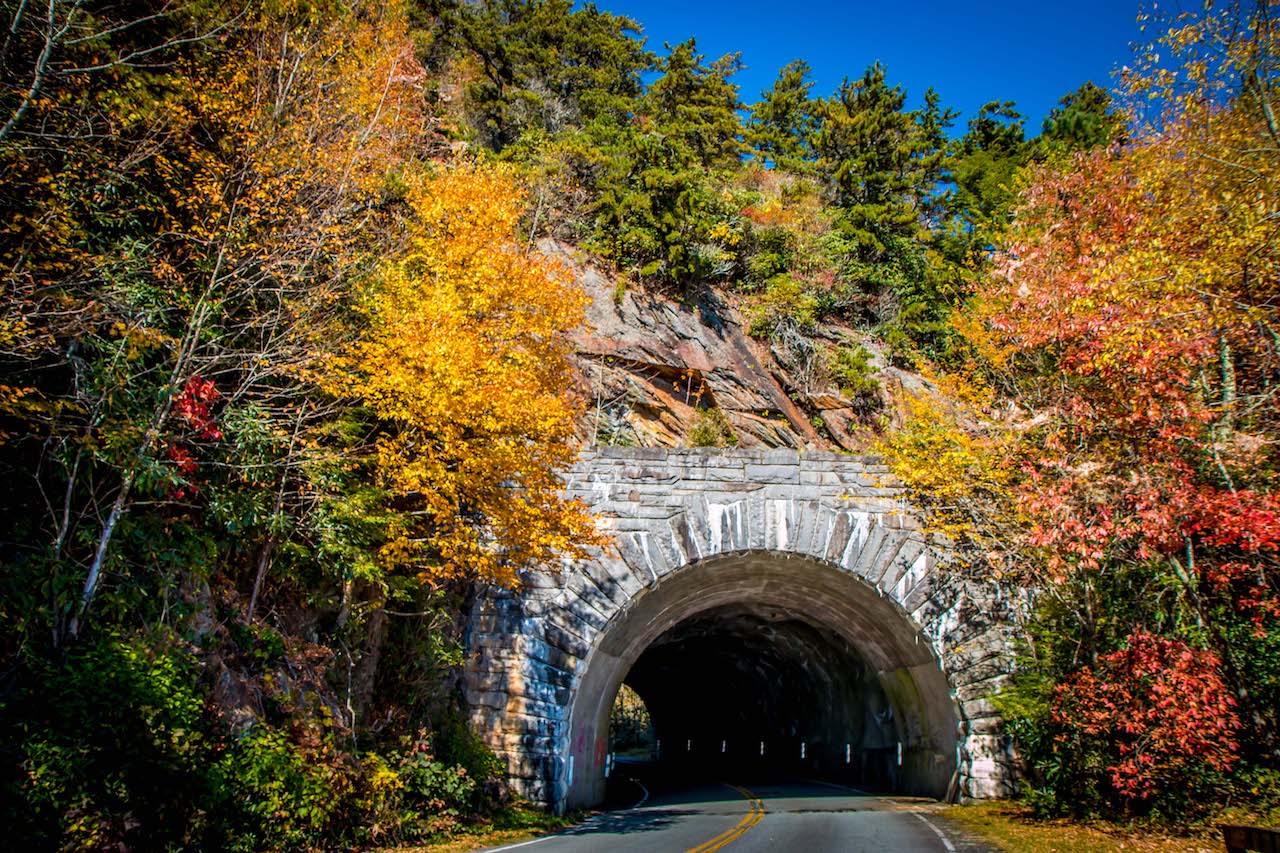
24. Little Switzerland
If seeing the North Carolina Fall foliage is a big priority, make sure your road trip includes a stop at Little Switzerland.
The tiny Alpine town is located right along the Blue Ridge Parkway at Milepost 334. It’s the only commercial access point you’ll find on the BRP, with several hotels, restaurants, and charming little shops.
There are lots of great places in Little Switzerland to see fall colors, but two of our favorites include the areas around the Emerald Village Gem Mines and Crabtree Falls, one of the most beautiful waterfalls in Western NC.
You can also see stunning sights while exploring the BRP, driving the winding roads of the scenic Diamondback 226 route, or getting some fresh apples from the historic Orchard at Altapass.
READ MORE: 15 Best Things to Do in Little Switzerland NC
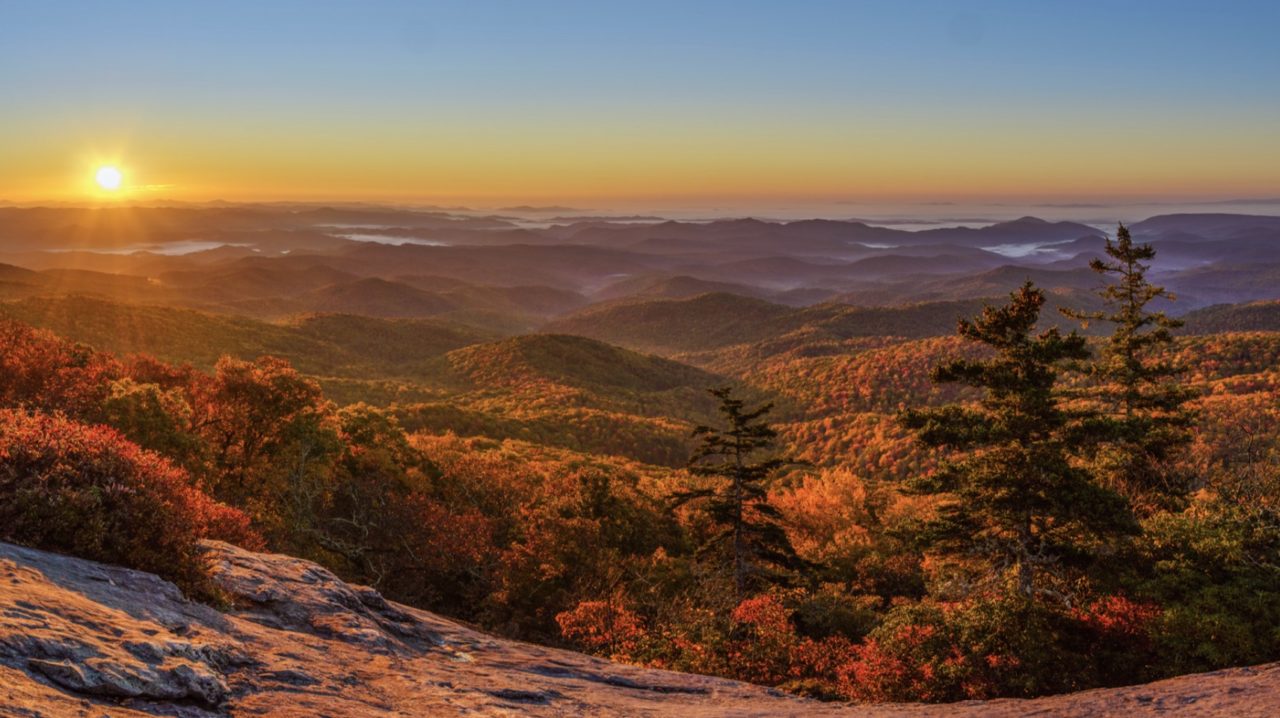
25. Beacon Heights Overlook
Located at Milepost 305.2 on the Blue Ridge Parkway (near Linville Falls NC), the Beacon Heights Overlook is home to one of the most beloved BRP hiking trails.
The moderate hike is relatively short at just 0.8 miles round-trip, but the breathtaking vistas it offers along the way make it a must-see when the fall colors in North Carolina start popping.
There are two big rock outcroppings at the mountain’s summit, offering sensational views of the surrounding scenery that seem to stretch endlessly.
On clear, sunny days, you’ll be able to see the neighboring Calloway Peak at Grandfather Mountain, as well as the massive summits of Mount Mitchell and Table Rock Mountain on the horizon.
READ MORE: 10 Wonderful Yadkin Valley Wineries Worth Visiting

1. Where is the best fall foliage in North Carolina?
Visiting in October to early November will offer excellent views of the Fall colors in the mountains of Western NC. The best Fall foliage in North Carolina can be seen via the Blue Ridge Parkway, especially around the Linn Cove Viaduct, Rough Ridge, the Pisgah Inn, and Graveyard Fields. There’s also a killer view from atop Clingmans Dome, as well as on the Forest Heritage National Scenic Byway near Brevard.
2. What month has the best fall colors in North Carolina?
Nature can be fickle, so it’s impossible to give exact dates when Fall colors will peak. But in our experience mid-October to early November offers the best color, so October in North Carolina is the best month for leaf-peeping. Trees at higher elevations will turn first, with trees at the lowest elevation changing last. But we have a fairly long Fall foliage season, giving you plenty of opportunities to catch a show.
3. How long do fall colors last in North Carolina?
Starting at the highest elevations in September and moving to the lowest in November, there are a good 6+ weeks to see NC’s Fall foliage. If you’re an early bird, head to the 6,000-foot summits of the Smoky Mountains. By mid-October, aim for altitudes of 3,000-5,000 feet, such as Grandfather Mountain. By the end of the month, lower altitude towns like Cherokee NC should hit the spot.
4. When can you see fall colors in Asheville?
Making Asheville your base offers endless opportunities to see Fall colors, with Pisgah National Forest and the BRP just a stone’s throw away. Come in September to see the earliest leaves turn at high altitudes on Mount Mitchell, or October for cruising the Forest Heritage National Scenic Byway. By early November, low altitude spots like Lake Lure and Chimney Rock will have the most colorful areas. —by Jonathon Engels, Bret Love & Emma Gallagher; lead photo courtesy Bryson City/Swain County Chamber of Commerce

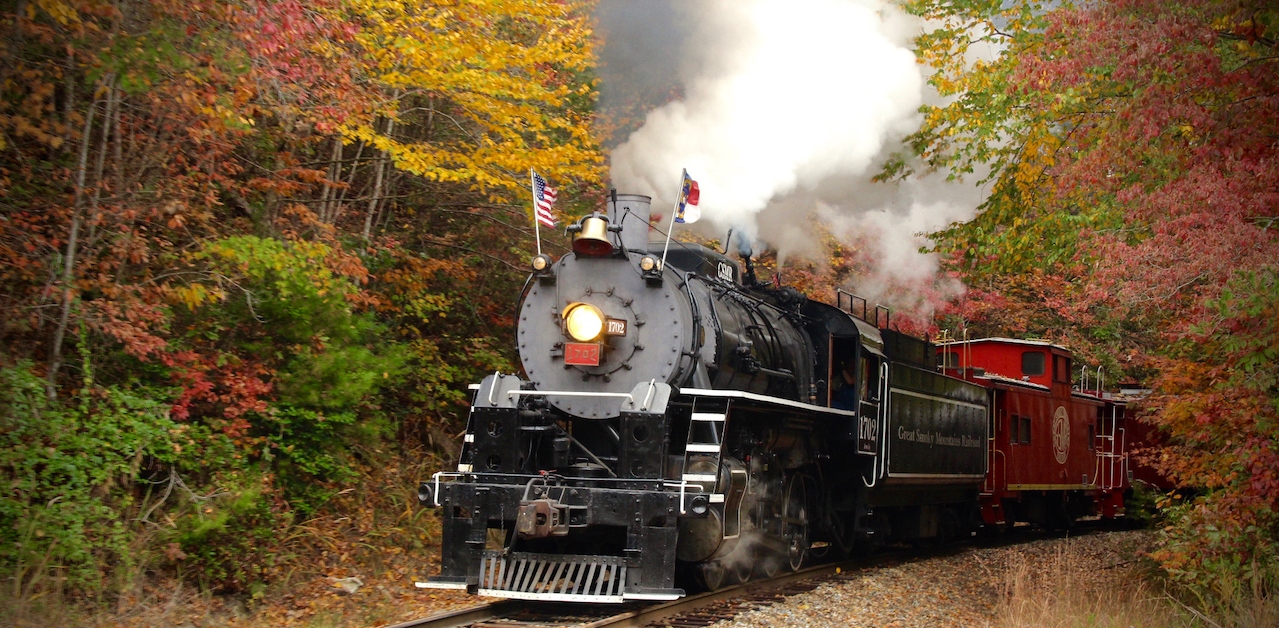

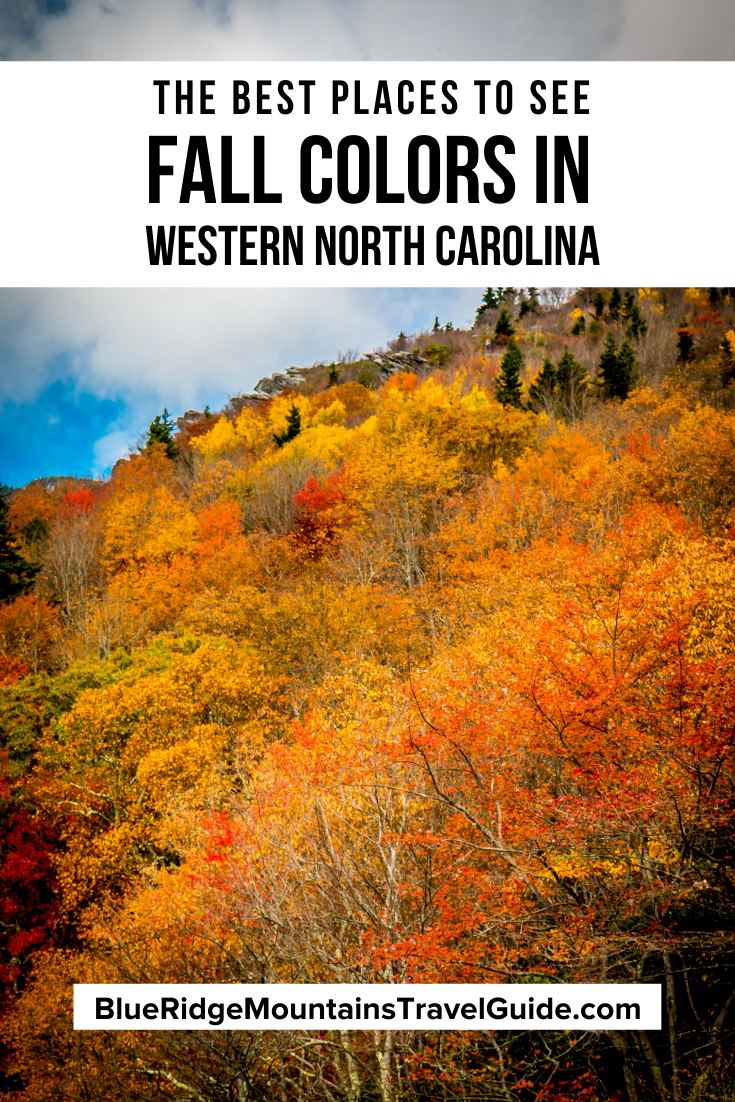
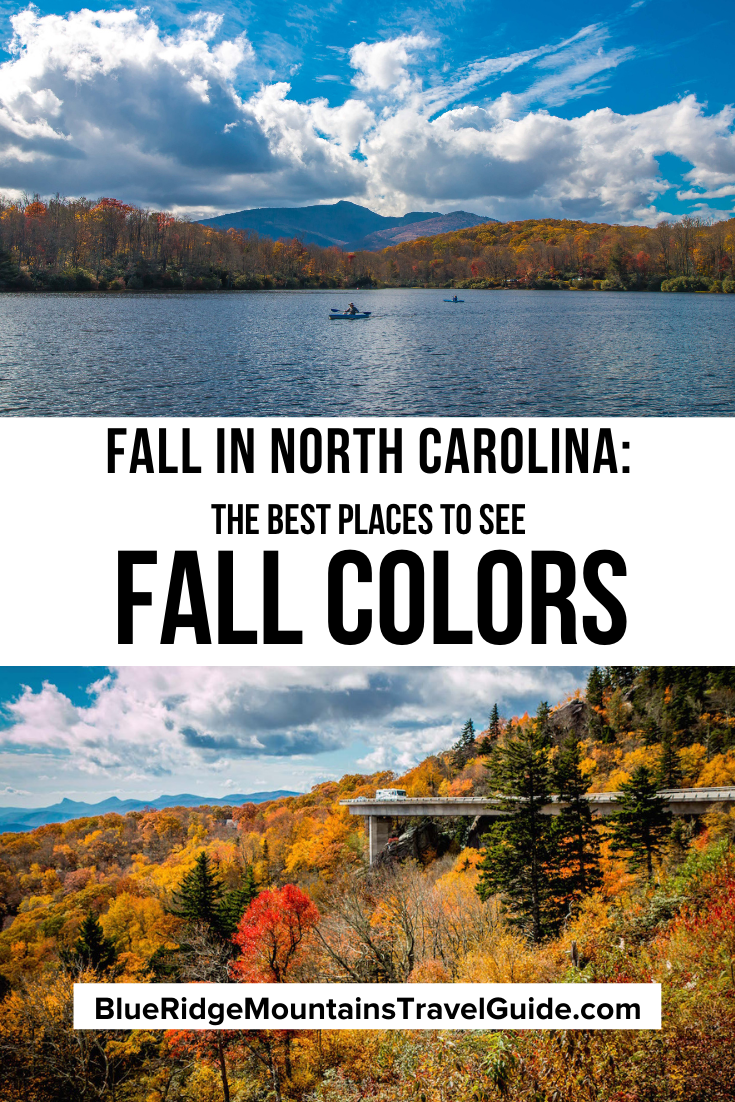

Comments are closed.